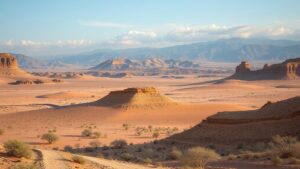Exploring the role of the mysterious “Fire Caves” of Iran in ancient Zoroastrian rituals.
Exploring the Role of the Mysterious Fire Caves of Iran in Ancient Zoroastrian Rituals
The Fire Caves of Iran are not just geological formations; they hold significant historical and spiritual value, particularly within the context of ancient Zoroastrian rituals. These caves, often referred to as Atash Kadeh (houses of fire), provide critical insights into the practices and beliefs of one of the worlds oldest known monotheistic religions, Zoroastrianism. In this article, we will delve into the origins, significance, and enduring legacy of these enigmatic sites.
Historical Background of Zoroastrianism
Zoroastrianism is believed to have been founded by the prophet Zoroaster (or Zarathustra) around 1000 BCE in ancient Persia, which is today Iran. religion emphasizes the duality of good and evil, centered on the worship of Ahura Mazda, the supreme god. Fire holds a pivotal role in Zoroastrian worship, symbolizing purity, truth, and the divine spirit. The fire caves served as vital places of worship and meditation, embodying the principles foundational to Zoroastrian beliefs.
Geographical Context and Locations
The most well-known fire caves are located across various regions of Iran, notably in:
- Alborz Mountains: Surrounding Tehran, these caves were used for spiritual practices due to their isolation and natural beauty.
- Yazd: This historical city is home to several fire temples and caves, deeply linked to Zoroastrian rituals.
- Kerman: The cave systems here include vast caverns used for ancient ceremonies.
Significance of Fire in Zoroastrian Rituals
Fire plays a central role in Zoroastrian rituals, viewed as a manifestation of divine presence. fire caves served several purposes:
- Ritual Offerings: The caves were often used to conduct ceremonies that involved offerings to the fire, which was believed to transmit prayers to the divine.
- Spiritual Cleansing: Caves provided an environment for followers to seek purification through fire, aligning with their belief that fire cleanses both the spirit and the physical self.
- Community Gathering: Fire caves acted as communal spaces where worshippers could come together to celebrate festivals such as Nowruz, the Persian New Year, which emphasizes rebirth and renewal.
Ritual Practices Within the Fire Caves
Rituals conducted in the fire caves varied but often included the following elements:
- Prayers (Gathas): Devotional songs and hymns were recited, aligning with the teachings of Zoroaster.
- Fire Tending: The maintenance of the sacred fire was critical, often requiring a dedicated priest or Mobad to oversee it.
- Charitable Offerings: Donations were made in the form of food and goods, reinforcing the Zoroastrian tenet of charity and community support.
Modern Relevance and Preservation of Fire Caves
Today, many fire caves remain, showcasing ancient Zoroastrian practices and beliefs. These sites are valuable for both religious observance and archaeological study. The increase in tourism has raised awareness of Zoroastrian culture, leading to efforts aimed at preserving these sacred sites. significance of the fire caves in contemporary Zoroastrianism continues to inspire followers worldwide.
Conclusion: The Legacy of Fire Caves
The mysterious fire caves of Iran stand as a testament to the enduring legacy of Zoroastrianism. They serve not only as historical landmarks but also as ongoing centers of spiritual significance. As Zoroastrian communities continue to engage with their rich heritage, the fire caves remain vital in understanding ancient rituals and practices. e sanctuaries of fire continue to capture the imagination, symbolizing the perennial flame of faith that Zoroastrianism represents.
In summary, the fire caves are more than mere geological formations; they encapsulate a profound religious heritage that has survived millennia, illustrating the resilience and adaptability of Zoroastrian traditions in a constantly changing world.



